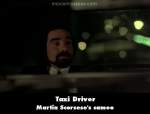Continuity mistake: In the scene where the man has DeNiro pull over to the curb and says he is going to kill his wife with a .44 gun, there is a close up of the meter clicking over to $2.75. In the next shot from the backseat, the meter reads $0.65.

Taxi Driver (1976)
Directed by: Martin Scorsese
Starring: Robert De Niro, Harvey Keitel, Jodie Foster, Peter Boyle, Albert Brooks, Cybill Shepherd
Suggested correction: The reason for that is because after Travis stopped the car, he turned off the meter. Then Scorcese's character asks what he's doing, and to put the meter back on. The $.65 indicates "$.65 first 1/6 mile" as clearly painted on the cab.
As the text of the original mistake stated, there is a close-up of the meter. A biiig one, that follows by quite a few seconds the meter being turned off. You can see the 0.65 before that close-up, you can see it after, it then changes to 0.75 and so on. This correction is totally wrong and the original post is correct.
Continuity mistake: In the scene at the diner, where Travis puts a soluble tablet in a glass of water, you can see a plate of open cheeseburger in front of him. But Travis never ordered, nor received any cheeseburgers. He only ordered and received a cup of coffee only. (00:17:10)
Other mistake: When Travis is negotiating with Sport for Iris' services, an off-screen crew member can be heard saying, "but no rough stuff" just before Sport says it. (01:17:00)

Trivia: Director Martin Scorsese makes more then just a cameo in this film, he's the passenger that sits with Travis talking about how he's going to kill his wife for cheating on him with a black man. He's credited as "Man Watching Silhouette".
Trivia: Robert De Niro worked as a cab driver for a month to prepare for the role.
Trivia: The assassination scene in this movie is said to have inspired John Hinckley Jr. to attempt to kill President Reagan. He did it to get Jodie Foster's attention.
Travis Bickle: All the animals come out at night - whores, skunk pussies, buggers, queens, fairies, dopers, junkies, sick, venal. Someday a real rain will come and wash all this scum off the streets.
Travis Bickle: [Into the mirror.] You talkin' to me? You talkin' to me? You talkin' to me? Then who the hell else are you talkin' to? You talkin' to me? Well, I'm the only one here. Who the f**k do you think you're talking to? Oh, yeah? Okay! [whips out gun.] Huh?
Travis Bickle: Loneliness has followed me my whole life, everywhere. In bars, in cars, sidewalks, stores, everywhere. There's no escape. I'm God's lonely man.
Question: When Travis goes into his fitness phase, it shows him hovering his fist over the stove fire. Why is he doing this? What does that achieve?
Answer: It helps him create a tolerance for pain. As we see, he certainly gets a lot of that dished out to him.
Question: Why was Travis labeled a hero at the end and not arrested? He murdered several people.
Chosen answer: One theory about the end of the film is that it is Travis' dying thoughts, but this is not the view of Scorsese or writer Paul Schrader...they intended the ending to be ambiguous and an ironic critique of the media's, and the public's, reaction to and interpretation of violence (Travis is hailed as a hero for rescuing Iris, but we can imagine a very different reaction had he followed his original plan of assassinating a senator). Interestingly, when the film was originally shown on television, the following "disclaimer" of sorts accompanied the closing credits: "In the aftermath of violence, the distinction between hero and villain is sometimes a matter of interpretation or misinterpretation of facts. 'Taxi Driver' suggests that tragic errors can be made. The Filmmakers."
Question: Is there an official explanation to the ending of the movie? Some people say that it was Travis's dream sequence, and others say it was Travis going back to his manic depressive self again. What caused Travis to get so startled when he was looking at the rear vision mirror? Did Scorsese deliberately make the ending very vague or is there supposed to be an explanation to the ending?
Answer: This is just my opinion. Remember Iris's line "Have you ever tried looking at your own eyeballs in the mirror?" or something to that effect. Well, Travis sees the madness reflected in his own eyes, doesn't like what he sees (as it reminds him of what he has done, what he might yet do).
Answer: There is. Both Scorsese (in the audio commentary) and screenwriter Paul Schrader in multiple interviews establish that the ending is not to be taken as a dream sequence or anything of the sort. I love the previous answer, by the way, it does nail what has also been stated; while Travis survived this time, it's very likely there will be a next.
Join the mailing list
Separate from membership, this is to get updates about mistakes in recent releases. Addresses are not passed on to any third party, and are used solely for direct communication from this site. You can unsubscribe at any time.
Check out the mistake & trivia books, on Kindle and in paperback.



